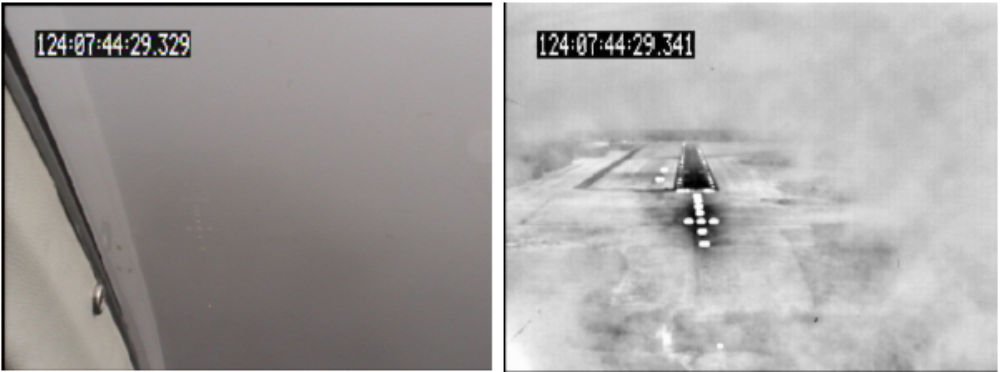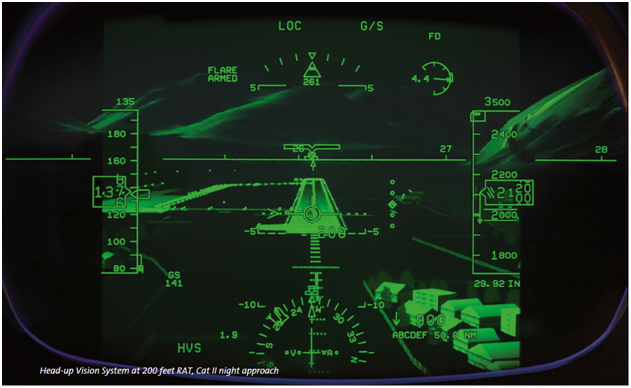Leeham News and Analysis
There's more to real news than a news release.
Leeham News and Analysis
- Boeing ponders 16/mo production rate for 787
- At long last, Boeing appears near certification and EIS for 777X
- Air India Flight 171 Preliminary Crash Report Is Unclear Regarding Pilot Actions
- Bjorn’s Corner: Air Transport’s route to 2050. Part 30.
- It’s official: MTU’s engine leader named CEO of Airbus Commercial from Jan. 1; future of Open Fan and A220-500 shifts to him
Bjorn’s Corner: LED runway lighting causes problems
August 19, 2016, ©. Leeham Co: I described in my Corner from 5th of August how a forward looking IR camera could add Enhanced Vision capabilities to a pilot’s tools for safe landings. The camera can pick up the infrared heat radiation from temperature differences in the nature down to a tenth of a degree. It can therefore see things that the naked eye can’t see.
Figure 1 is from a trail that FedEx did before equipping several of its freighters with Enhanced Vision Systems. The Infrared camera (right) can clearly see all heat-emitting objects around the runway, including the fields; the naked eye looking through the cockpit window (left) can’t see anything.

Figure 1. Naked eye (left) versus IR camera (right) when landing on a foggy day. Source: FedEx presentation.
This all works fine as long as the landing and runway lights emit heat, i.e., are standard incandescent types. But these are now replaced more and more with LED lights where there is no heat and therefore no appearance on the Enhanced Vision!
Will Enhanced Vision crumble before it took off? Luckily there is a solution.
Multispectral cameras
The change from incandescent to LED types for landing and runway lights is picking up speed. The electricity bill difference is huge and LED lights work just fine. They are as easy to see with the naked eye and they last longer and run cooler. The last advantage creates problems, however.
The Infrared-based Enhanced Vision systems sitting on FedEx freighters and Gulfstream, Bombardier or Dassault high-end business jets all pick up the heat the lights emit, not their visible light radiation. As the most powerful reference for landing in bad conditions is then lost, the future of Enhanced Vision System is threatened.
The solution is to use more advanced camera units. Rockwell Collins developed such a unit which uses not one but three spectral bands to make the system future-proof, Figure 2.
The classical short wave IR camera is there to pick up normal lighting and other heat-generating objects like an aircraft or a vehicle.
Then there is a new, long wave IR camera which is especially good in imaging the difference in emission of the runway/taxi ways and the surrounding terrain.
Finally, there is a visual light camera which is tuned to find any LED-based runway and taxi way lighting.
All these images are fused into one homogenous image which is then blended into the pilot’s Flight Display and Head-Up Display. Combined with a Synthetic Vision database, it gives a complete picture of the situation in front of the aircraft, independent of future runway/taxi way lighting systems, Figure 3.

Figure 3. HUD image of the EVS-3000 camera blended with Synthetic Vision and flight symbols. Source: Rockwell Collins.
The EVS-3000 camera is finding its first implementation on the mid-sized Biz jet Legacy 450 and 500 from Embraer, others will follow.
Share this:
- Click to print (Opens in new window) Print
- Click to email a link to a friend (Opens in new window) Email
- Click to share on X (Opens in new window) X
- Click to share on Pinterest (Opens in new window) Pinterest
- Click to share on Facebook (Opens in new window) Facebook
- Click to share on WhatsApp (Opens in new window) WhatsApp
- Click to share on LinkedIn (Opens in new window) LinkedIn
- Click to share on Tumblr (Opens in new window) Tumblr
- Click to share on Reddit (Opens in new window) Reddit
Related
Category: Bjorn's Corner, Bombardier, Embrarer
Tags: Bombardier, Dassault, EVS, FedEx, Gulfstream, Rockwell Collins, SVS




Wouldn’t it be a simpler solution to place a heating element into the lights with just enough power that it would be visible on IR systems, so when you have bad visual conditions, you can switch on the heating element ?
I guess the heating would consume the power that the LED saves, anyway the change to LED based lighting for landing and runway lights has begun, to late to stay with a short wave IR camera only. The new camera from R. Collins is un-cooled as well so it’s easy to install. Technology for sensors for the different electromagnetic wave bands move on fast, luckily.
I have read that one problem of LED lighting is that some pilots are complaining they are blindingly bright when taxiing! An easily solvable problem for sure but it just goes to show what a remarkable technology it is.
That HUD image btw is straight out of science fiction (see “escape from New York” glider scene).
https://upload.wikimedia.org/wikipedia/en/c/c7/Escape_From_New_York_Wireframe.jpg
What a marvelous time it is to be alive!
What melts the snow and ice covering the lights?
Well the LED lights will not. Same thing with LED headlights on your car. Driving in snowy conditions, ice and snow will block the LED lights. You may need to get out occasionally and clear the ice off.
Unintended concequences.
I would have thought that an infrared radiating LED could have been put in parallel with the visual light LED to keep the lighting compatible with the older equipment and still have significant power savings.
I thought LEDs were quite hot
“The wall-plug efficiency (optical power out divided by electrical power in) of LED packages is typically in the region of 5-40%, meaning that somewhere between 60 and 95% of the input power is lost as heat.”
“The energy consumed by a 100-watt GLS incandescent bulb produces around 12% heat, 83% IR and only 5% visible light. In contrast, a typical LED might produce15% visible light and 85% heat
http://www.ledsmagazine.com/articles/2005/05/fact-or-fiction-leds-don-t-produce-heat.html
Say we want 100W of visible light output from a light fixture. And we’ve got 15% efficient LEDs (easy and common to gets) and 5% efficient incandescent.
Heat Energy = Light Energy/Efficiency – Light Energy…
LED: 100/15% – 100 = 667 – 100 = 567W
Incan: 100/5% – 100 = 2000 – 100 = 1900W
Now granted only about 300W of the incandescent with be raw waste heat, but a good portion 1600W of broad spectrum IR energy will also end up being absorbed locally and effectively be turned into heat for all intents and purposes.
And high quality LEDs can hit 40%+ efficiency which works out to only 150W of waste heat.
So yes, on a purely light basis, incandescent can be ~90% efficient, but 90%+ of that light is generally useless and tends to immediate cause additional local heating.
In the real world LEDs generate about 1/10th the amount of energy visible in the IR spectrum for a given visible spectrum energy level.
Maybe the simpler answer is the heat in a incandescent is in the bulb and the heat in the LED is in the base where it gets dissipated into the surround metal?
You could as well add an IR LED to the visible emitters.
Doesn’t cost much, doesn’t take much energy either
If there isn’t much energy, there won’t be much heat (IR) radiation, either.
Don’t any of these airport operators live where it snows? Our community switched to LEDs in traffic lights, and they now have been retrofitted with heaters to prevent the build up of snow and ice. The heaters are actually controlled by a sensor that can see if the lens is clear or not.
There have been many lawsuits finding local governments negligent for allowing traffic controls to be ineffective in snow storms. I can’t wait for the issues with airport lighting.
Have to wonder how much the whole thing costs vs the savings. Probably still worth it long term.
Glad I have Halogens in the car!
Since the heater only comes on when the lens needs it I imagine it’s still quite cheaper to operate than the incandescents.Also the life span of the leds mean they practically never need replacing which saves even more.